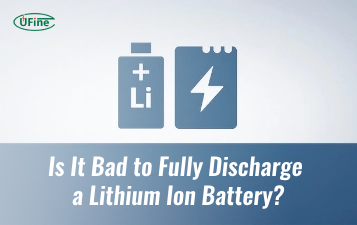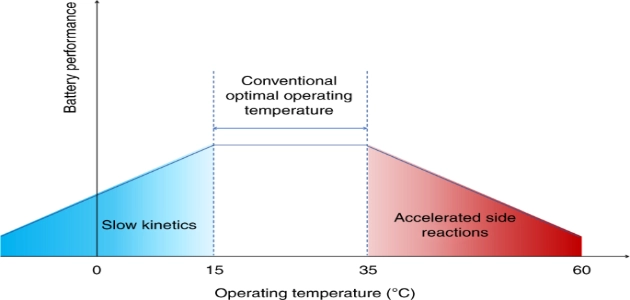
- Part 1. Why temperature ranges matter for lithium battery performance?
- Part 2. Optimal Lithium Battery Operating Temperature & Maximum Limits
- Part 3. How extreme temperatures affect lithium battery performance?
- Part 4. Recommended storage temperatures for lithium batteries
- Part 5. Lithium battery charging and discharging at extreme temperatures
- Part 6. Strategy for managing lithium battery temperatures
- Part 7. In summary
- Part 8. FAQs about lithium ion battery temperature range
Optimal Lithium Battery Temperature Range for Performance and Safety Lithium-ion batteries operate best between 15°C to 35°C (59°F to 95°F) for usage and -20°C to 25°C (-4°F to 77°F) for storage. Maintaining these ranges maximizes efficiency, lifespan, and safety. Exceeding these limits can cause performance loss, battery heating, or safety hazards. Understanding lithium ion battery operating temperature and limits is essential for devices in extreme conditions.
Part 1. Why temperature ranges matter for lithium battery performance?
Battery heating and cooling directly impact lithium ion battery temperature range, affecting efficiency, runtime, and chemical stability. Maintaining an optimal thermal environment ensures long-lasting performance.
Maintaining the appropriate temperature range is vital for maximizing the efficiency and lifespan of lithium batteries. Operating lithium batteries outside their recommended temperature range can lead to reduced capacity, diminished performance, accelerated aging, and even safety hazards.
Part 2. Optimal Lithium Battery Operating Temperature & Maximum Limits
Optimal Temperature Range
- Lithium batteries work best between 15°C to 35°C (59°F to 95°F).
- This range ensures peak performance and longer battery life.
- Battery performance drops below 15°C (59°F) due to slower chemical reactions.
- Overheating can occur above 35°C (95°F), harming battery health.
Effects of Extreme Temperatures
- Freezing temperatures (below 0°C or 32°F) can freeze the battery’s electrolyte, causing permanent damage.
- High temperatures (above 60°C or 140°F) can speed up battery aging and pose safety risks.
- Extreme temperatures shorten battery lifespan and reduce efficiency.
- Controlled environments and thermal management systems help maintain safe battery temperatures.
- Regular temperature monitoring prevents damage and ensures battery safety.
Lithium Battery Temperature Effects on Battery Heating and Performance:
| Temperature Range | Performance Impact | Recommendations |
|---|---|---|
| -20°C to 0°C (-4°F to 32°F) | Electrolyte freezing, significant capacity loss, reduced battery heating efficiency | Avoid usage; consider insulation or warming to maintain optimal performance. |
| 15°C to 35°C (59°F to 95°F) | Optimal performance, maximum efficiency, proper battery heating for optimal performance | Best for usage and charging. |
| 35°C to 60°C (95°F to 140°F) | Overheating, reduced lifespan, risk of thermal runaway, excessive battery heating | Use cooling systems to manage temperature. |
| Above 60°C (140°F) | Severe degradation, high safety risk, uncontrolled battery heating | Avoid at all costs; ensure proper ventilation and thermal management. |
Part 3. How extreme temperatures affect lithium battery performance?
Performance at Low Temperatures
Understanding lithium battery temperature range helps predict performance drop at low temperatures. Li-ion batteries may show up to 30% capacity loss below 0°C (32°F).
- In cold temperatures, like below 15°C (59°F), lithium batteries experience reduced performance.
- Chemical reactions within the battery slow down, causing decreased power output.
- Shorter battery life and diminished capacity result from these conditions.
- Devices may shut down unexpectedly in extreme cold due to reduced battery efficiency.
Performance at High Temperatures
Battery heating beyond 35°C (95°F) accelerates aging and may trigger thermal runaway, highlighting lithium battery maximum temperature concerns.
- High temperatures above 35°C (95°F) also impact lithium battery performance.
- Excessive heat accelerates chemical reactions, causing the battery to degrade faster.
- Overheating can lead to thermal runaway, a dangerous condition where the battery can catch fire or explode.
- Prolonged exposure to high temperatures shortens battery lifespan and increases safety risks.
- Devices may experience performance issues or even failure in extreme heat.
Part 4. Recommended storage temperatures for lithium batteries
Recommended Storage Temperature Range
For lithium-ion battery storage, keeping cells within -20°C to 25°C (-4°F to 77°F) preserves capacity and minimizes self-discharge, ensuring long-term reliability.
Proper storage of lithium batteries is crucial for preserving their performance and extending their lifespan. When not in use, experts recommend storing lithium batteries within a temperature range of -20°C to 25°C (-4°F to 77°F). Storing batteries within this range helps maintain their capacity and minimizes self-discharge rates. Storing batteries at temperatures above 25°C (77°F) can accelerate the aging process, while storing them below -20°C (-4°F) may cause irreversible damage.
Storage Considerations in Extreme Climates
- Insulation or heated storage areas can prevent batteries from freezing in freezing climates.
- Storing batteries in cool, shaded areas or climate-controlled environments is recommended for scorching climates.
- Avoid leaving batteries in vehicles exposed to direct sunlight, as temperatures inside can exceed safe limits.
- During transport in extreme climates, insulated packaging or temperature-controlled containers can protect batteries from temperature fluctuations.
- Regularly monitor storage conditions and take appropriate measures to store batteries within recommended temperature ranges.
Part 5. Lithium battery charging and discharging at extreme temperatures
Charging at Extreme Temperatures
Battery heating management during charging ensures efficient energy absorption and prevents safety hazards caused by high temperature operation.
- Charging lithium batteries at extreme temperatures can harm their health and performance.
- At low temperatures, charging efficiency decreases, leading to slower charging times and reduced capacity.
- High temperatures during charging can cause the battery to overheat, leading to thermal runaway and safety hazards.
- It’s best to charge lithium batteries at temperatures within the recommended range of 0°C to 45°C (32°F to 113°F) to ensure optimal performance and safety.
Discharging at Extreme Temperatures
- Discharging lithium batteries at extreme temperatures also affects their performance and lifespan.
- The battery’s internal resistance increases at low temperatures, reducing power output and capacity.
- High temperatures during discharge can accelerate chemical reactions, leading to faster degradation and capacity loss.
- Operating devices powered by lithium batteries in extreme temperatures can result in reduced runtime and potential damage to the battery.
- Avoid discharging lithium batteries in temperatures below -20°C (-4°F) or above 60°C (140°F) whenever possible to maintain battery health and prolong lifespan.
Part 6. Strategy for managing lithium battery temperatures
Thermal Management Systems
Using thermal management systems helps keep the lithium ion battery operating temperature within safe limits, preventing degradation and improving lifespan.
- Thermal management systems help regulate the temperature of lithium batteries during operation.
- Typical systems include heat sinks, cooling fans, thermal pads, and temperature sensors.
- Heat sinks dissipate excess heat from the battery to prevent overheating.
- Cooling fans improve airflow around the battery, aiding in heat dissipation.
- Thermal pads provide insulation to maintain stable temperatures within the battery.
- Temperature sensors monitor the battery’s temperature, allowing for real-time adjustments to thermal management systems.
Environmental Control Measures
- Environmental control measures involve controlling the temperature of the surroundings where lithium batteries are used or stored.
- This includes maintaining ambient temperatures within the optimal range of 15°C to 35°C (59°F to 95°F).
- Avoid exposing batteries to extreme temperatures, such as in hot cars or direct sunlight.
- Store batteries in cool, shaded areas to prevent overheating.
- Use climate-controlled environments or insulated storage solutions to maintain stable temperatures in extreme climates.
- Regularly monitor temperature conditions using temperature sensors to keep batteries within the recommended range for optimal performance and safety.
Part 7. In summary
Maintaining the recommended temperature range is essential for maximizing the performance and longevity of lithium batteries. Operating within 15°C to 35°C (59°F to 95°F) for usage and -20°C to 25°C (-4°F to 77°F) for storage minimizes degradation and safety risks. By implementing proper temperature management strategies, lithium batteries can deliver optimal performance and reliability in diverse applications.
Explore More:
Lithium Ion Battery Storage Temperature Guide
Part 8. FAQs about lithium ion battery temperature range
What is the safe operating temperature for lithium batteries?
Lithium batteries operate best between 15°C to 35°C (59°F to 95°F). Temperatures outside this range can degrade performance and safety.
Can lithium batteries work in freezing temperatures?
Operating lithium batteries below 0°C (32°F) can cause electrolyte freezing, leading to permanent damage. Pre-heating or insulation can mitigate this.
How do I store lithium batteries in extreme climates?
Use insulated or climate-controlled storage solutions to maintain temperatures between -20°C to 25°C (-4°F to 77°F). Avoid direct sunlight and freezing environments.
Why do lithium batteries overheat?
Overheating occurs due to excessive chemical reactions, poor ventilation, or charging/discharging at high temperatures. Implement cooling systems to prevent overheating.
What is the maximum temperature for lithium batteries?
The lithium battery maximum temperature for safe operation is around 60°C (140°F). Exceeding this can damage the battery and pose safety risks.
How does temperature affect lithium battery performance?
Temperature affects chemical reactions, internal resistance, and capacity. Optimal ranges maximize performance and lifespan, while extreme heat or cold reduces efficiency.
Related Tags:
More Articles

Is It Bad to Fully Discharge a Lithium Ion Battery?
Discover what happens if a lithium battery is fully discharged and how to safely recharge 12V batteries to prevent permanent damage.
Does a Higher mAh Battery Last Longer?
Does a higher mAh battery really last longer? Learn what mAh means, real battery life in hours, replacement safety (4000 vs 5000mAh), and real examples.
Exploring the Lithium Ion Battery Fire Temperature
Discover the lithium-ion battery fire temperature and learn how to stay safe. Get essential tips to prevent battery fires and protect your devices today.
The Ultimate Guide to 6s Lipo Batteries
A beginner-friendly guide to 6S LiPo batteries. Understand voltage, capacity, charging tips, safety rules, and real-world applications.
What is the NCMA battery? What is the difference between it and the NMC battery? Which one is better? This article will answer your questions.



